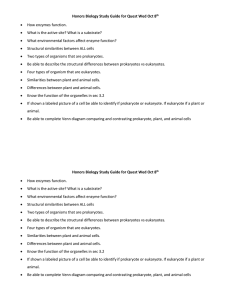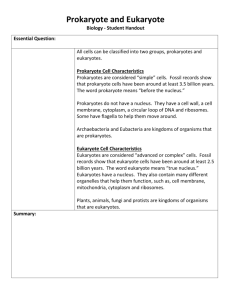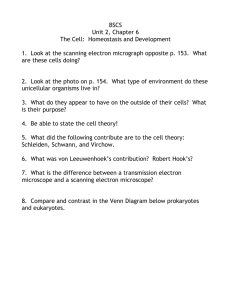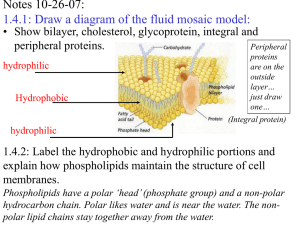File
advertisement
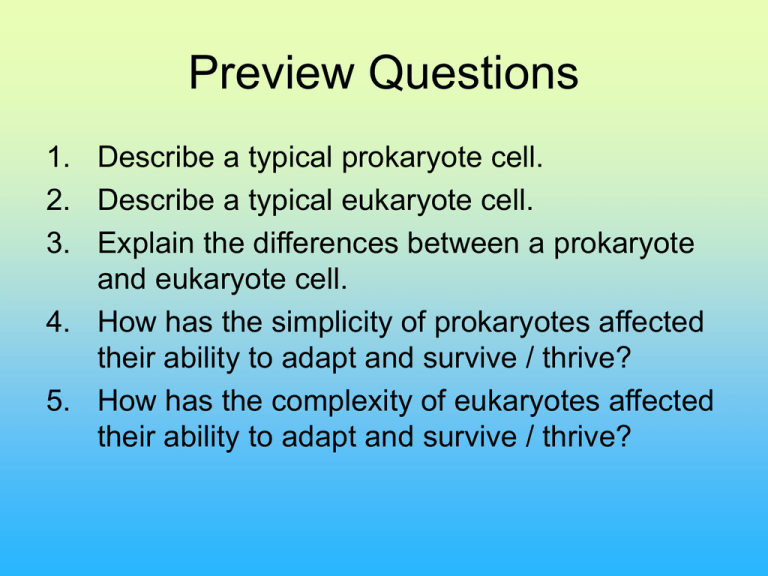
Preview Questions 1. Describe a typical prokaryote cell. 2. Describe a typical eukaryote cell. 3. Explain the differences between a prokaryote and eukaryote cell. 4. How has the simplicity of prokaryotes affected their ability to adapt and survive / thrive? 5. How has the complexity of eukaryotes affected their ability to adapt and survive / thrive? Cell theory 1. All living things are made of cells 2. Cell can only come from other cells 3. All functions of a living thing are carried out in cells • Reminder: the functions of living things are: respiration, metabolism, growth, adaptations to the environment, reproduction, homeostasis and interdependence Different Types of Cells An overview There are two main groups of cells, prokaryotic and eukaryotic cells. Similarities: all are alive, all belong to one of the five life kingdoms. Differences: appearance, structure, reproduction, and metabolism. – . biggest differences are between cells of different kingdoms Where to begin? • Prokaryotes are simpler, so we will start with them. VS Diagrams courtesy - http://www.cod.edu/people/faculty/fancher/ProkEuk.htm Prokaryotes were formed about 3.5 billion years ago, or 3,500,000,000 years Prokaryotes from the Greek meaning “before nuclei” Why “before nuclei?” • Prokaryotic cells have no nucleus. – Prokaryote’s DNA is circular (it has no ends). – Small circlets of DNA are called Plamids. • Prokaryotic DNA is “naked” – it has no histones associated with it and does NOT form chromosomes All Prokaryotes are in the monera kingdom domains Bacteria and Archaea – bacteria – Cyanobacteria • also known as bluegreen algae Prokaryote Characteristics 1. Simplest organisms: Very small size. 2. Lack membrane-bound organelles inside the cell 3. have few internal structures that are distinguishable under a microscope. 4. genetic information is in a circular loop called a plasmid (instead of having chromosomal DNA) 5. Strong cell walls: resistant to environmental changes 1. Size • Bacterial cells are very small, • about 1-2µm in diameter and 10 µm long – One micrometer = 1/1000 mm. • Imagine looking at a dime from its thinnest side and trying to slice it into a thousand pieces; that is the same as 1 µm. 2. Lack membrane-bound organelles inside the cell 3. have few internal structures that are distinguishable under a microscope. http://www.umanitoba.ca/science/biological_sciences/lab3/biolab3_2.html#Examine 4. genetic information is in a circular loop called a plasmid • E. coli cell dividing. • E. Coli Grows in human intestine; – Has a single, circular chromosome – contains DNA as plasmids • Plasmids are extrachromosomal DNA http://www.bio.mtu.edu/campbell/prokaryo.htm 5. Strong cell walls: resistant to environmental changes Bacterial Structure Shapes 3 basic shapes Cocci - sphere Bacilli - rods Spirilla – spirals Spiral This spiral shaped bacteria is the causitive agent of syphilis Treponema pallidum Rod shaped 2 basic groupings Staph - in clusters Strep - in chains Spherical Streptococcus sp. Chains of nearlyspherical bacteria. From The Rockefeller University. Replication • Binary fission – one cell splits into two cells, see diagram • offspring are genetically identical to parent Movement Some prokaryotes can't move, while others have long threadlike flagella. E.Coli flagella If bacteria doesn’t move, how does it get from person to person? Prokaryote Functions • • • • decomposers agents of fermentation play important roles in digestive systems involved in many nutrient cycles – ex: the nitrogen cycle, which restores nitrate into the soil for plants. • diverse array of metabolic functions. – For example, some bacteria use sulfur instead of oxygen in their metabolism. Eukaryotes From the Greek for “true nucleus” Example cells from the plantae and animalia kingdoms Plant (elodea) animal cells (blood vessel lining) Eukaryote characteristics All eukaryotes have … 1) A Cell membrane 2) A Central nucleus 3) Organelles in cytoplasm (like ER, vacuoles, mitochondria, etc.) size and shape are related to cell function. For Example: 1. birds’ eggs are large because they contain all the nutrient material that the developing bird embryo will need during its growth to a young chick. 2. 1. 2. Muscle cells are long, so that they can contract and shorten up, thereby moving body parts. 3. Nerve cells are also long — they need to transmit nerve signals to different parts of the body 4. epithelial cells are broad and flat 5. red blood cells are especially small because they need to get through the smallest capillaries of the circulatory system. 3. 4. 5. Structure – animal cell Structure – plant cell reproduction *Mitosis – body cells *Meiosis – gametes (egg & sperm) Movement Internal 1. The centriole 2. The cytoskeleton 3. Actin and tubulin proteins External 4. Flagella 5. cilia 1. 2. 3. 4. 5. Review Prokaryote & Eukaryote similarities Both have 1. DNA 2. A cell membrane 3. Ribosomes 4. Diverse forms (meaning a lot of shapes and sizes) Prokaryotes & Eukaryotes differences Prokaryotes Eukaryotes •Plasmid DNA •No membranebound organelles •Few things inside (are simple) •Nuclear bound DNA •Has membrane bound organelles •Many things inside (Are complex) **Organelles are tiny structures inside cells that do a certain job. Complete this Vinn Diagram worksheet and turn it in Prokaryote Write the things that are Different here Write things that are the Same here Eukaryote Write the things that are Different here Characteristic Prokaryote Eukaryote Size 1-10um 10-100um Nuclear Envelope Absent present Chromosomes Single, circular, no nucleus Multiple, linear, wound on nucleosomes Golgi apparatus Absent Present ER, Lysosomes Absent Present Mitochondria Absent Present Chlorophyll Not in chloroplasts Present in chloroplasts Ribosomes Relatively small Relatively large Microtubules, filaments, microfilaments Absent Present Flagella Lack microtubules Contain microtubules Review Questions 1. Describe a typical prokaryote cell. 2. Describe a typical eukaryote cell. 3. Explain the differences between a prokaryote and eukaryote cell. 4. How has the simplicity of prokaryotes affected their ability to adapt and survive / thrive? 5. How has the complexity of eukaryotes affected their ability to adapt and survive / thrive?
